| ORANGE COUNTY TRACKERS |
COPYRIGHT 2010 DICK NEWELL
| A BASIC STUDY OF ANIMAL GAITS AND PATTERNS |
Interpreting patterns and understanding gaits can be a frustrating experience for the novice tracker. Much of the following information was originally developed by Mark Elbroch * and reported in his outstanding text on Mammal Tracks & Sign and it was only after studying his work that track patterns started to make much sense.
The absolute best way to begin to understand gaits is to watch animals moving. This can be done by watching live animals in the zoo or perhaps at a local dog park, or by studying wildlife programs or videos. While a few animals have a unique gait, most will use a variation of one or more of the following.
We are going to divide the most common animal gaits in to four types. The first two are the WALK and the TROT. In each of these there is a balance, a rhythmic set to the feet landing and with no noticeable break between each set of four tracks.
The next two gaits we will look at are the LOPE and the GALLOP. Novices can remember these two belong together as the word "lope" is contained within the word "gallop".
Each of these two gaits will be distinguished by a large space or gap showing between each set of four tracks and the sets will not be balanced.
The absolute best way to begin to understand gaits is to watch animals moving. This can be done by watching live animals in the zoo or perhaps at a local dog park, or by studying wildlife programs or videos. While a few animals have a unique gait, most will use a variation of one or more of the following.
We are going to divide the most common animal gaits in to four types. The first two are the WALK and the TROT. In each of these there is a balance, a rhythmic set to the feet landing and with no noticeable break between each set of four tracks.
The next two gaits we will look at are the LOPE and the GALLOP. Novices can remember these two belong together as the word "lope" is contained within the word "gallop".
Each of these two gaits will be distinguished by a large space or gap showing between each set of four tracks and the sets will not be balanced.
When an animal starts to walk or move slowly it begins by moving
both of the legs on one side of its body before moving the legs on
the other side. Usually it begins by moving one of its hind legs
followed by the front leg on the same side. About the time these two
legs have completed their movement the legs on the other side of
the body will move in a similar fashion. This is frequently referred to
as an "alternate" foot movement or walking gait. When you see this
gait in the dirt you will observe a front track followed by the hind
track of the same side and they will be directly in line with each
other. On the other side of the center line of the animal’s trail you
will observe a similar pattern but ahead of or behind the first set by
a distance equal to that of the space between the hips and shoulder
of the animal. There will be a rhythmic pattern to these tracks with
no noticeable breaks between the sets, ie., 1-2-3-4-1-2-3-4-1-2-3-4
etc. As the speed of the walk increases the front foot track may be
behind that of the hind track.
both of the legs on one side of its body before moving the legs on
the other side. Usually it begins by moving one of its hind legs
followed by the front leg on the same side. About the time these two
legs have completed their movement the legs on the other side of
the body will move in a similar fashion. This is frequently referred to
as an "alternate" foot movement or walking gait. When you see this
gait in the dirt you will observe a front track followed by the hind
track of the same side and they will be directly in line with each
other. On the other side of the center line of the animal’s trail you
will observe a similar pattern but ahead of or behind the first set by
a distance equal to that of the space between the hips and shoulder
of the animal. There will be a rhythmic pattern to these tracks with
no noticeable breaks between the sets, ie., 1-2-3-4-1-2-3-4-1-2-3-4
etc. As the speed of the walk increases the front foot track may be
behind that of the hind track.
 |
| THE WALK |
 |
| THE TROT |
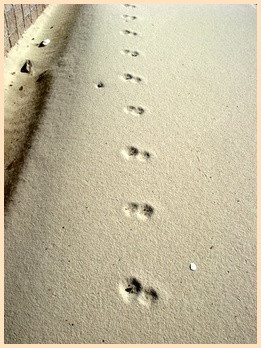
As an animal starts to increase its speed it will shift to a trot. This is a "diagonal" foot movement meaning that as the left-hind leg starts to move forward the right-front leg will move forward at the same time and same distance, followed by the right-hind leg and left-front legs moving in unison. When you see this gait in the ground you may observe the two right tracks together on one side and the two left tracks together on the other side. The hind track may be alongside of the front, on top of it, in front of it or behind it depending on the type of trot and the speed of the animal. Generally, if the hind foot is put down behind the front foot it is a slower gait and if the hind foot passes the front foot it is a faster gait. As the speed of the trot increases the width of the trail will decrease. Never-the-less there will be a rhythmic pattern to these tracks with no noticeable breaks between the sets, ie., 1-2-1-2-1-2-1-2, etc. Number one indicating a left and a right foot landing at the same time and number two being the other two feet landing at the same time. Look for an increased distance between the sets to distinguish the trot from a walk.
 |
| THE LOPE |
To facilitate an increase in speed the animal will shift to either a lope or a gallop. After each set of four tracks you will notice a considerable space that generally increases in distance as the speed of the animal increases. This free space produces an unequal or unbalanced pattern.
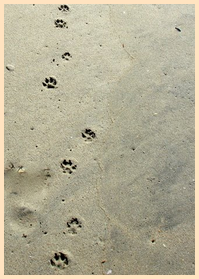
 |
| THE GALLOP |
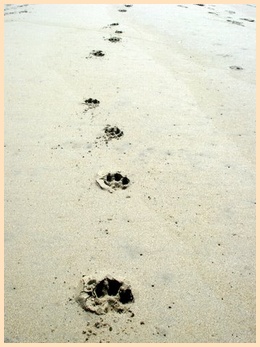
In the gallop you might observe an even greater space between the
sets and you will also notice that the first two tracks will always be the front feet followed by the hind feet.
The hind feet may or may not
land side-by-side but again, they will always be in the following
sequence: front, front, rear, rear.
sets and you will also notice that the first two tracks will always be the front feet followed by the hind feet.
The hind feet may or may not
land side-by-side but again, they will always be in the following
sequence: front, front, rear, rear.
 |
Each species has its own preferred gait and each track pattern may
differ somewhat but that also makes identifying the species and
interpreting the track easier. Some animals such as rodents,
rabbits, weasels, etc, will normally use a bounding movement which
is really a gallop while others such as the felines and the fox will
often direct register (one foot print directly on top of another).
Remember that it is the time you spend in the dirt studying the
tracks that will bring understanding and along with that will come
the great pleasure of learning more about nature.
differ somewhat but that also makes identifying the species and
interpreting the track easier. Some animals such as rodents,
rabbits, weasels, etc, will normally use a bounding movement which
is really a gallop while others such as the felines and the fox will
often direct register (one foot print directly on top of another).
Remember that it is the time you spend in the dirt studying the
tracks that will bring understanding and along with that will come
the great pleasure of learning more about nature.
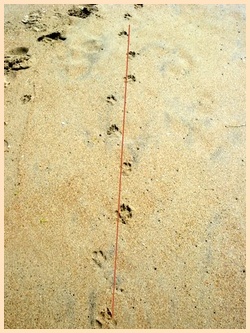
* MARK ELBROCH'S pre-eminent website, WILDLIFE TRACKING IN NORTH AMERICA, can be reached HERE.
 |
There are two types of lopes. In the first example you will observe a front track followed by a hind track followed by the other front and then the other hind. Notice that these will always alternate. It will show in the dirt as 1-2-3-4 --- 1-2-3-4 ---
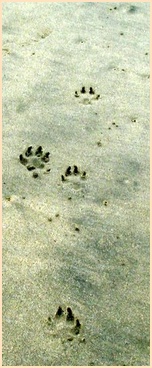
In the second example we have what is called a 3x4 lope. It will show in the dirt as 1-2/3-4... The first track will always be a front foot and the last one will always be a hind foot. What makes this particular lope different than the other is the position of the middle two tracks which will either be side-by-side or partially overlapping. The rule for interpreting this gait is that if any portion of the center two tracks overlap, then the gait must be deemed to be a lope.
